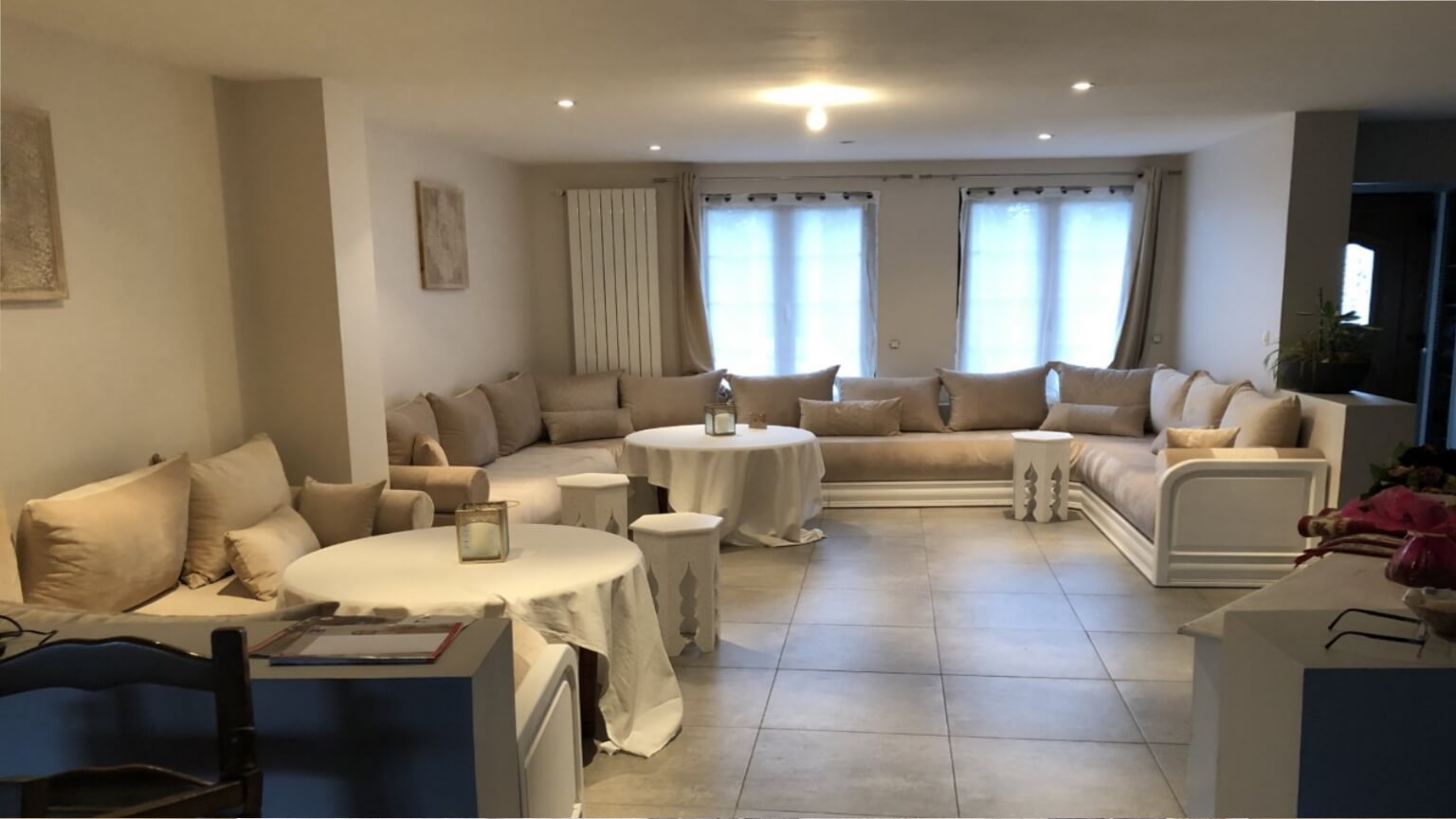Étape 1 : Vérifier si vos murs forment un angle droit.
Pour vérifier si vos murs forment un angle droit, mesurez trois longueurs différentes de votre pièce à équidistance les unes des autres. Si la longueur totale de votre pièce est de 250 cm, prenez donc vos mesures sur les deux largeurs et à 125 cm des largeurs. (voir schéma ci-dessous)

Si votre pièce est droite : les 3 dimensions seront les mêmes à 1 cm près.
Si ce n’est pas le cas, c’est ici : Comment prendre mes mesures si ma pièce n’est pas droite ?
Sinon si votre pièce est bien droite, vous pouvez passer à l’étape suivante !
Étape 2 : Y-a-t-il des obstacles ? (Radiateurs, plaintes …)


Si vous n’avez aucun obstacle dans votre pièce, vous pouvez passer directement à l’étape 3.
Gardez en tête qu’un canapé marocain couvre plusieurs murs est en angle droit. Sauf si vous choisissez de séparer le canapé.

S’il y a des radiateurs, poteaux ou d’autres obstacles qui vous gênent, il existe 3 solutions :
- Créer un canapé sur mesure tenant compte de vos obstacles (à privilégier en cas de petits obstacles tels que les plaintes.)
- Ajouter des dossiers à votre canapé pour ne pas avoir besoin de l’accolé au mur.
- Créer un canapé « désassemblé » avec des pièces de canapé entre les objets encombrants.
Voici un exemple de canapé marocain sur mesure réalisé par nos soins et adapté aux dimensions d’une pièce. On peut observer qu’il y avait ici une contrainte (le poteau). Pour contourner cet obstacle nous avons choisi avec notre client l’option numéros 3.

Revenons maintenant sur chacune des options possibles.
1.Créer un canapé sur mesure tenant compte de vos objets encombrants
On adapte les dimensions du canapé selon la taille l’obstacle. Certaines pièces ont donc des largeurs et longueurs différentes.

Voici le cas le plus complexe à réaliser.
Ici le client demande un canapé Marocain avec des dimensions très précises qui vont lui permettre de créer un canapé accolé au mur tout en demandant des dimensions sur mesure de manière à ce que le canapé contourne le radiateur.

2. Ajouter des dossiers à votre canapé pour ne pas avoir besoin de l’accolé au mur.
On évite donc l’obstacle en le contournant et en laissant un espace vide (zone hachuré)

Explication de l’exemple :
Pour contourner l’obstacle du radiateur, on peut choisir de prendre un dossier. Avec un dossier, il n’y a plus besoin d’être accolé contre le mur, on peut donc laisser un écart suffisant pour le radiateur. Ainsi, les contraintes dimensionnelles sont beaucoup plus limitées.

3. Créer un canapé « désassemblé » avec des pièces de canapé entre les objets encombrants.

Explication de l’exemple :
Pour contourner le ou les obstacles, il est tout à fait possible de séparer le canapé en plusieurs pièces qui ne sont pas reliées les unes aux autres. C’est une technique qui ne demande aucun coûts supplémentaire, il s’agit simplement d’une question d’esthétique et de perte d’espace.
On peut également combler les vides avec d’autres meubles qui viendront embellir le salon.

Étape 3 : Faites votre croquis avec vos dimensions
Vous pouvez imprimer et utiliser le modèle ci-dessous pour réaliser votre croquis. Nous l’avons fait pour illustrer les 3 exemples précédents. Il vous suffit simplement de partir des pointillés et de dessiner le croquis de votre canapé.
N’oubliez pas de préciser le plus de dimensions possibles. Si vous souhaitez obtenir un devis ou simplement un conseil, vous pouvez directement nous envoyer votre croquis par mail : contact@moncanapemarocain.com
Ou nous appeler directement : 03.21.48.30.83


